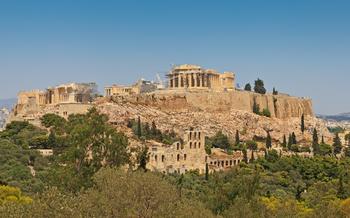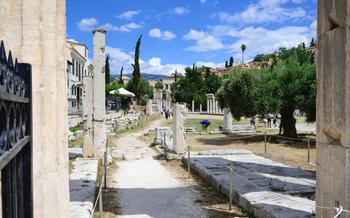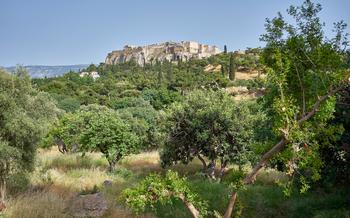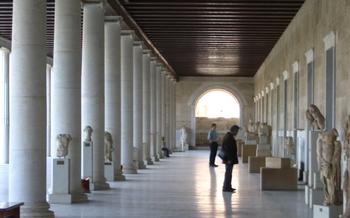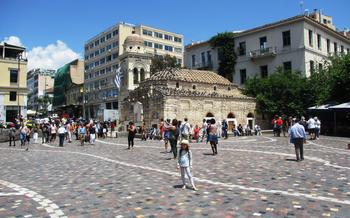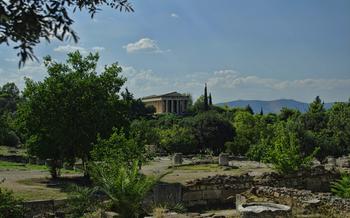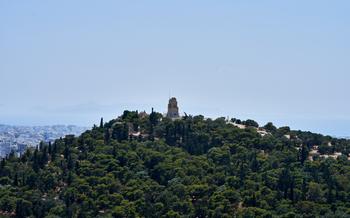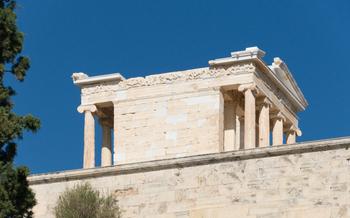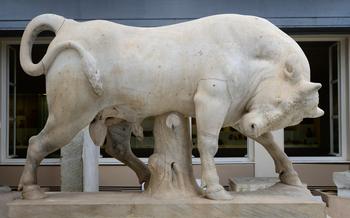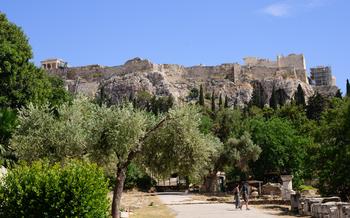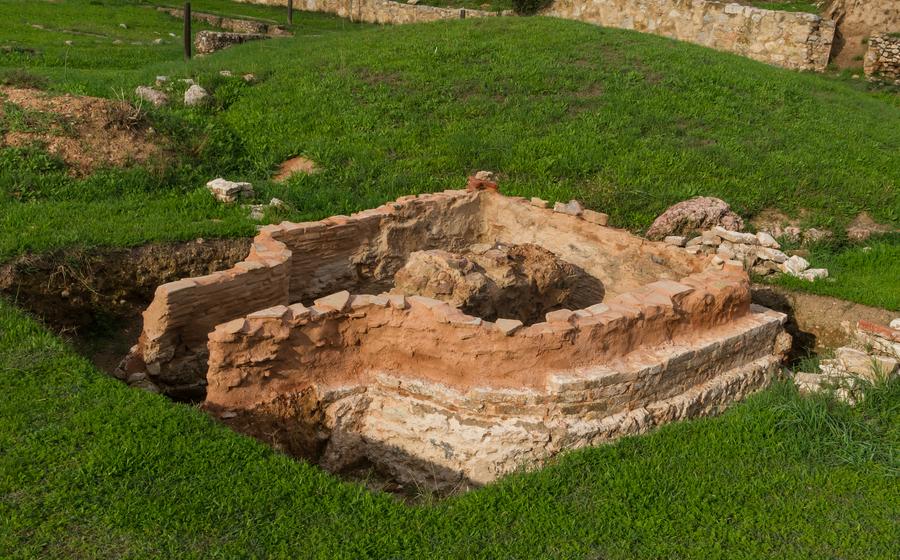
Kerameikos Cemetery
- A Walk Through History
- Unveiling the Sacred Way
- Exploring the Tombs and Monuments
- The Dipylon Gate and the City Walls
- The Museum of Kerameikos
- The Archaeological Site
- The Neighborhood of Kerameikos
- Planning Your Visit
- The Ancient Agora of Athens
- The National Archaeological Museum
- The Hill of the Nymphs
- The Philopappos Monument
- The Pnyx Hill
- The Temple of Hephaestus
- Insider Tip
A Walk Through History
The Kerameikos Cemetery, a sprawling necropolis located west of the ancient city of Athens, offers a unique glimpse into the lives and customs of the ancient Greeks. Established in the 12th century BC, the cemetery served as the final resting place for countless Athenians, including prominent statesmen, philosophers, and artists. Its historical significance lies in its role as a microcosm of ancient Athenian society, reflecting the city's cultural, religious, and artistic traditions.
As you wander through the evocative ruins of the Kerameikos Cemetery, you'll encounter a diverse array of tombs and monuments, each telling a story of the individuals buried within. From simple earthen graves to elaborate stone sarcophagi, these tombs showcase the evolving burial practices and customs of ancient Athens. Discover the poignant inscriptions and intricate reliefs that adorn the tombstones, offering insights into the lives, hopes, and fears of the departed.
Unveiling the Sacred Way
The Sacred Way was an ancient road that connected Athens to the sanctuary of Eleusis, located about 20 kilometers west of the city. It was considered a sacred route, as it was used for the annual Eleusinian Mysteries, a major religious festival in ancient Greece.
During the Eleusinian Mysteries, a grand procession would take place along the Sacred Way, led by priests and priestesses carrying sacred objects. Thousands of pilgrims from all over Greece would participate in the procession, which culminated in the sanctuary of Eleusis, where secret rituals and ceremonies were held.
The Sacred Way was not just a religious route, but also an important trade and communication artery. It was lined with shops, workshops, and other buildings, and served as a vital link between Athens and the rest of the region.
Archaeological excavations along the Sacred Way have revealed a wealth of artifacts and monuments, including statues, altars, and inscriptions. These discoveries have shed light on the religious and cultural practices of ancient Athens, and have helped to reconstruct the history of the Eleusinian Mysteries.
Exploring the Tombs and Monuments
The Kerameikos Cemetery boasts a diverse array of tombs and monuments, each reflecting the social status, wealth, and artistic tastes of the deceased. From simple earthen graves to elaborate marble mausoleums, these structures provide a glimpse into ancient Greek burial customs and beliefs.
The most common type of tomb in the Kerameikos Cemetery is the shaft tomb, a rectangular pit lined with stone and covered with a stone slab. These tombs were typically used for the burial of ordinary citizens and their families. More elaborate tombs, such as the chamber tomb, featured multiple chambers and were often decorated with frescoes, sculptures, and inscriptions. These tombs were reserved for wealthy and prominent individuals, such as politicians, military leaders, and religious figures.
The tombstones in the Kerameikos Cemetery are particularly noteworthy for their artistic value and symbolism. Many tombstones feature intricate carvings depicting scenes from mythology, daily life, or the afterlife. These carvings provide valuable insights into ancient Greek beliefs about death and the hereafter.
The Funerary Stele of Hegeso, for example, is one of the most famous tombstones in the cemetery. This beautifully carved stele depicts a young woman, Hegeso, seated in a chair and holding a dove in her hand. The stele is a poignant reminder of the love and loss experienced by the ancient Greeks.
By exploring the tombs and monuments of the Kerameikos Cemetery, visitors can gain a deeper understanding of ancient Greek art, culture, and society. These structures offer a unique glimpse into the lives and beliefs of the people who once called Athens home.
The Dipylon Gate and the City Walls
The Dipylon Gate, located on the western side of the Kerameikos Cemetery, was one of the most important gates of ancient Athens. It served as the main entrance to the city from the west and was a major crossroads for travelers and traders. The gate was named after its double doors, which were constructed to allow for the passage of both wheeled vehicles and pedestrians.
The Dipylon Gate held great significance in ancient Athens. It was the starting point of the Sacred Way, a processional route that led to the sanctuary of Eleusis, where the Eleusinian Mysteries were held. These mysteries were religious rituals that played a crucial role in Athenian society and were believed to hold the key to the afterlife.
The gate also witnessed several historical events. In 480 BC, the Persian army under Xerxes I entered Athens through the Dipylon Gate and sacked the city. In 338 BC, Alexander the Great triumphantly returned to Athens through the same gate, marking the beginning of a new era for the city.
Today, visitors can still see the remains of the Dipylon Gate, including the foundations of the towers that flanked the entrance. The gate provides a glimpse into the grandeur of ancient Athens and serves as a reminder of its rich history and cultural significance.
The Museum of Kerameikos
The Museum of Kerameikos, located within the archaeological site, houses a captivating collection of artifacts unearthed from the cemetery. Step inside to embark on a journey through ancient Athenian history and culture. Interactive displays bring to life the stories behind the tombs and monuments, immersing you in the rituals and beliefs of the past.
Explore exhibits showcasing funerary objects, pottery, jewelry, and sculptures that once adorned the graves of prominent citizens. Learn about the symbolism and significance of these artifacts, gaining insights into the lives and customs of ancient Athenians. The museum also features educational programs and workshops, providing an opportunity to delve deeper into the fascinating world of ancient Greek funerary practices.
The Archaeological Site
The Kerameikos Archaeological Site is a treasure trove of ancient ruins and artifacts, offering visitors a glimpse into the rich history and culture of ancient Athens. The site is well-organized and easy to navigate, with clearly marked paths and signage. Highlights include the Pompeion, a large building used for religious processions, and the Sacred Well, a deep pit used for offerings to the gods. Ongoing excavations and research continue to uncover new discoveries, adding to our understanding of ancient Athenian life.
To make the most of your visit, it's helpful to have a map or guidebook to help you identify the different features of the site. You can also take a guided tour, which will provide you with expert insights into the history and significance of the cemetery. Whether you choose to explore on your own or with a guide, be sure to wear comfortable shoes and bring water, as there is limited shade on the site.
The Neighborhood of Kerameikos
The Kerameikos neighborhood, located in the northwestern part of Athens, is steeped in history and cultural significance. Once home to the ancient Kerameikos Cemetery, the area has evolved into a vibrant neighborhood with a unique blend of ancient ruins and modern life.
Strolling through the streets of Kerameikos, one can't help but feel a sense of connection to the past. The neighborhood is dotted with well-preserved ancient monuments, including the Dipylon Gate, the Sacred Way, and the Pompeion, offering a glimpse into the lives and rituals of the ancient Athenians.
In addition to its historical significance, Kerameikos is also a vibrant and diverse neighborhood with a strong cultural identity. The area is home to numerous art galleries, theaters, and cultural centers, showcasing the creative spirit of modern Athens. Visitors can enjoy a variety of cultural events, exhibitions, and performances throughout the year.
For those seeking culinary delights, Kerameikos offers a diverse range of restaurants and cafes, serving everything from traditional Greek cuisine to international fare. Whether you're in the mood for a hearty meal or a quick snack, you'll find plenty of options to satisfy your taste buds.
With its rich history, cultural attractions, and vibrant atmosphere, the Kerameikos neighborhood is a must-visit for anyone exploring Athens. It's a place where the past and present seamlessly blend, creating a unique and unforgettable experience for visitors from all over the world.
Planning Your Visit
Visiting the Kerameikos Cemetery is a rewarding experience for anyone interested in ancient history, archaeology, or simply exploring Athens' hidden gems. To make the most of your visit, here are some practical tips:
- Best time to visit: The best time to visit the Kerameikos Cemetery is in the spring or fall when the weather is mild and pleasant. During the summer months, the heat can be oppressive, and the crowds can be larger.
The Ancient Agora of Athens
Just a short walk from the Kerameikos Cemetery lies the ancient Agora of Athens, another significant archaeological site that offers a glimpse into the heart of ancient Athenian life. Once the bustling commercial, political, and social center of the city, the Agora was a place where people gathered to trade, debate, and celebrate.
Today, visitors can explore the ruins of this ancient marketplace, including the well-preserved Temple of Hephaestus, the Stoa of Attalos, and the Altar of the Twelve Gods. The Agora Museum houses a collection of artifacts unearthed from the site, providing further insight into the daily lives of the ancient Athenians.
A combined ticket allows visitors to explore both the Kerameikos Cemetery and the Ancient Agora, offering a comprehensive understanding of ancient Athenian culture and history.
The National Archaeological Museum
The National Archaeological Museum in Athens houses one of the world's most renowned collections of ancient Greek artifacts. Among its extensive exhibits, visitors can find numerous artifacts related to the Kerameikos Cemetery, offering a deeper insight into the funerary customs and beliefs of ancient Athenians.
The museum displays a variety of grave stelae and funerary sculptures from the cemetery, providing a glimpse into the artistic styles and iconography of the period. These stelae often depict scenes from everyday life, religious rituals, or mythological tales, offering valuable insights into the social and cultural context of ancient Athens.
One of the highlights of the museum's collection is the famous Mourning Athena, a 4th-century BC statue that adorned the tomb of Dexileos, a young Athenian cavalryman who died in battle. This poignant sculpture captures the grief and sorrow of a female figure, believed to represent Athena, the goddess of war and wisdom.
In addition to funerary artifacts, the museum also houses an impressive collection of sculptures, pottery, jewelry, and other objects from the Kerameikos Cemetery. These artifacts provide a comprehensive overview of the artistic and cultural achievements of ancient Athens and offer a glimpse into the lives of the people who once inhabited this vibrant city.
The Hill of the Nymphs
Situated a short distance from the Kerameikos Cemetery, the Hill of the Nymphs offers a unique blend of history, nature, and panoramic vistas. Ascend the hill's verdant slopes to discover the remains of ancient fortifications, remnants of a bygone era when Athens faced threats from invading forces. Archaeological excavations have unearthed intriguing artifacts, providing glimpses into the lives of those who once inhabited this strategic vantage point.
Crowning the hilltop, immerse yourself in breathtaking views that encompass the sprawling metropolis of Athens. Gaze upon the iconic Acropolis, with its majestic Parthenon standing as a testament to ancient architectural prowess. Allow your eyes to wander across the cityscape, tracing the contours of modern buildings that seamlessly blend with the vestiges of the past. The Hill of the Nymphs emerges as an oasis of tranquility amidst the urban bustle, inviting you to pause and appreciate the timeless beauty of Athens from a unique perspective.
The Philopappos Monument
At the southeastern edge of the Kerameikos Cemetery, atop a rocky outcrop, stands the imposing Philopappos Monument. This grand funerary structure was erected in the 2nd century AD to honor Gaius Julius Antiochus Philopappos, a Roman consul of Greek descent.
The monument comprises a rectangular base adorned with intricate bas-reliefs depicting scenes from Philopappos' life and achievements. These reliefs offer valuable insights into the customs and traditions of ancient Rome and provide a glimpse into the life of a prominent citizen.
The most striking feature of the monument is its towering cylindrical chamber, which once held Philopappos' ashes. The chamber is topped by a conical roof, reminiscent of a tholos, a type of circular building common in ancient Greek architecture.
From the Philopappos Monument, visitors can enjoy breathtaking views of the Acropolis, the ancient Agora, and the surrounding cityscape. The monument stands as a testament to the enduring legacy of ancient Greece and the cultural exchange that took place between Greece and Rome during the Roman period.
The Pnyx Hill
Overlooking the ancient Agora, the Pnyx Hill played a pivotal role in the development of democracy in Athens. This rocky outcrop served as the assembly site for Athenian citizens, where they gathered to debate and make decisions on matters of governance. The hill's natural amphitheater-like formation allowed for the participation of a large number of citizens, fostering a sense of civic engagement and equality.
Standing atop the Pnyx Hill, visitors can almost feel the echoes of ancient Athenian democracy reverberating through the air. It was here that renowned orators, such as Pericles and Demosthenes, delivered their impassioned speeches, swaying the opinions of the assembled citizens. The hilltop offers a breathtaking panorama of Athens, with the Acropolis, the Temple of Hephaestus, and the Kerameikos Cemetery all visible in the distance.
Today, visitors can explore the well-preserved remains of the Pnyx, including the stone benches where the citizens sat, the speaker's platform, and the boundary markers that defined the voting area. It is a place to reflect on the origins of democracy and its profound impact on Western civilization.
The Temple of Hephaestus
Within a short walking distance from the Kerameikos Cemetery lies the well-preserved Temple of Hephaestus, a testament to the architectural prowess of ancient Athens. Dedicated to the Greek god of fire, metalworking, and craftsmanship, the temple stands as a symbol of the city's industrial and artistic heritage.
Constructed in the late 5th century BC, the Temple of Hephaestus boasts an impressive Doric style, characterized by its simple yet majestic lines. Its well-proportioned columns and intricate pediments, adorned with sculptures depicting the labors of Hephaestus and other mythological scenes, showcase the exceptional craftsmanship of the ancient Greeks.
Despite the passage of time and the ravages of history, the Temple of Hephaestus remains remarkably intact, a testament to the enduring legacy of ancient Greek architecture. Its proximity to the Kerameikos Cemetery offers a unique opportunity to explore the sacred and secular aspects of ancient Athenian life.
As you stand before this architectural marvel, let your imagination transport you back to a time when Hephaestus, the divine patron of artisans, was revered and celebrated. Marvel at the intricate details and harmonious proportions that make this temple a masterpiece of classical architecture.
Insider Tip
For a unique perspective of the Kerameikos Cemetery, climb to the top of the Philopappos Hill. From this vantage point, you can capture stunning panoramic shots of the ancient tombs and monuments, set against the backdrop of the Acropolis and the city skyline. The hill also offers hidden gems like the ancient quarries, where you can explore the rock formations and discover remnants of past excavations.
To savor the authentic flavors of Greek cuisine, venture into the heart of the Kerameikos neighborhood. Along Ermou Street, you'll find a plethora of traditional tavernas and restaurants serving delicious dishes made with fresh, local ingredients. Indulge in mouthwatering souvlaki, sample the hearty moussaka, or savor the aromatic pastitsio, all while immersing yourself in the vibrant atmosphere of this historic district.
